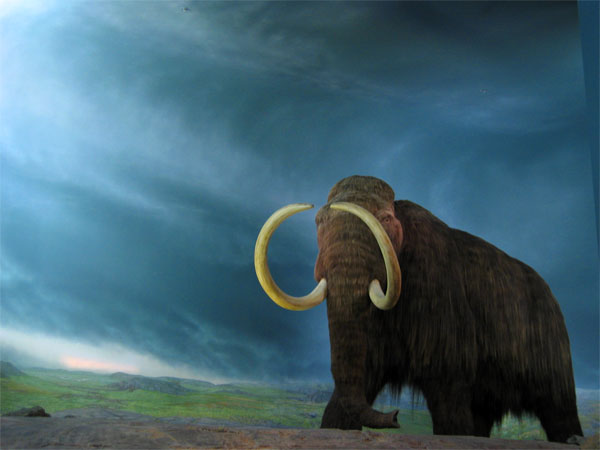 RE-POST FROM 2.2008*
RE-POST FROM 2.2008*I came across an encouraging article on the USDA-ARS website. They describe a project to develop perennial warm and cool season grasses to supply ranchers on the Great Plains with forage for their cattle year-round. Many of these varieties are based on native species, improved for standard agronomic traits such as ease of seed collection. Grass-fed beef is relatively green as it doesn't require fossil fuel-intensive corn and soybean feed and doesn't produce burdensome concentrations of manure**. The American prairie co-evolved with numerous (mostly extinct) herbivores in the first place, and in the end a grassland grazed by cattle isn't much different than one grazed by bison.
This reminded me of this old letter to Nature from a few years ago (Re-wilding North America). The authors argued that we could simultaneously restore North American ecosystems and conserve endangered species by introducing animals such as elephants, camels and lions to open preserves in the United States. North America had many native large mammals prior to human colonization (including several elephant, horse, camel and lion species). It's likely that the late colonization of humans with sophisticated technology drove this whole class of animals to extinction here as it had in Australia. The introduction of similar species from Africa, in their minds, would restore our native ecosystems to a more pristine and functional state (for example, they point out that the pronghorn antelope probably co-evolved closely with the now-extinct American cheetah).
I think their most interesting argument is that this project could increase the public's dedication to preserving wild lands in general. They cite that more people visit the San Diego zoo's wild animal park each year than the National Park system. They propose that humans have an innate aesthetic interest in watching large herbivores and that the dedication of new wildlife parks could be justified by introducing these animals (many hunting ranches are apparently already stocked with such animals in Texas). These new parks could be established in economically depressed regions to simultaneously benefit local communities and justify the preservation of large tracts of undeveloped land.
This reminds me of the recent Pennsylvania Wilds project, which was created to bring tourism dollars to rural PA, and largely revolves around the re-introduction of elk (for watching and highly-coveted hunting licenses). I think we should take this a step further. Cloning technology will soon*** allow us to produce reasonable facsimiles of many of the large mammals that our ancestors recently drove to extinction. It seems to me that if the United States can make room for wild populations of wolves, bears, bison and moose then it could certainly support other similar, formerly extinct species... or at least the likes of passenger pigeons. These resurrected organisms won't be identical to the animals we drove to extinction thousands of years ago. More often than not, they will be rough behavioral and morphological hybrids with existing species. I don't see why this should be a deal-breaker though. The authors of the Nature paper point out that the highly acclaimed re-establishment of the extinct Midwest peregrine falcon was really done by breeding other peregrine falcon subspecies from around the world. Not the same thing, but still very much worth it.
I think the reintroduction of charismatic extinct animals and the dedication of new wildlife parks could really energize the public to value wild lands and the lifestyle choices that preserve them. With all the inaction-inducing guilt usually associated with environmental awareness, I think it could be worth it to show that extinction isn't always forever.
*Because I spent all night writing a post about Osage oranges and realized I wanted to link to this idea. I have a few re-posts in queue from my old grad school blog (where I mostly complained about being in grad school)
**yeah, but inefficient = expensive
***Well, I think 10-15 years is an okay guess. The nitty gritty challenges of synthesizing and assembling large genomes are pretty daunting, but JCVI is making some impressive progress.

Wow, That sounds great. I always wanted a pet Dinosaur. I will name him/her/it Denver.
ReplyDeleteI will argue the point of human colonization of the americas was with sophisticated technology. I doubt that humans had sophisticated weapons as archaelogical evidence suggests that they had stone clovis point spears for the longest time. What they did have was the aspect of being "invasive," meaning that the animals were unaware of what humans could do and therefore were unafraid due to lack of exposure.
It also didnt help that early american's favorite way of killing large animals was running whole herds off the sides of cliffs...
I really thought Jared Diamond's hypothesis on the loss of megafauna in the america's is quite valid - and hence the abstract version above (animals being unaware of what humans could do). Pair that up with longer gestation periods for larger animals (i.e. slower reproductive rates), mass killings, and the fact that it is hard for a big animal to hide, one would think that extinction would shortly follow.
Kind of like the Golden Grizzly Bear of California...